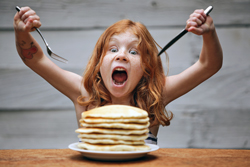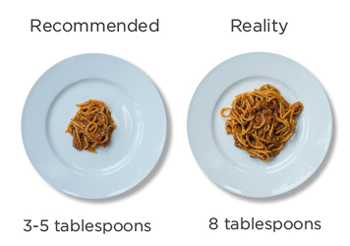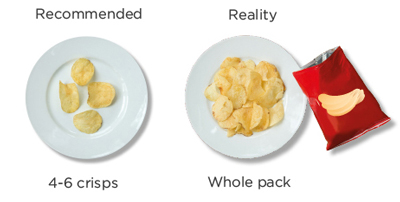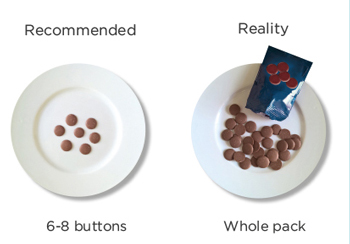Parent Feeders: Are You Feeding Your Toddler Too Much?
Surveys show that more than 10% of parents usually serve their child close to an adult-size** portions By Judy More, Paediatric Dietitian & Nutritionist specialising in children’s nutrition Recent research reveals that some UK parents are overfeeding their 1-4 year olds with 1 in 10 parents giving their pre-schoolers near adult size portions. With the latest figures showing that one in five children are overweight or obese by the time they start school (1), practical advice is urgently needed. Parents are Putting Too Much on the Plate The research of 1000 UK mums and dads (2) revealed that 79%* of parents routinely offer portions bigger than the recommended size range for pre-schoolers when serving popular meals (such as spaghetti bolognese and chicken nuggets with chips), drinks and treats. The survey, which involved parents looking at images of portion sizes, also showed that more than 10% of parents usually serve their child close to an adult-size** portion of spaghetti bolognese or cheese sandwiches.
Did You Know?
- A serving of Spaghetti Bolognese for a 1-4 year old should be 3-5 tablespoons
- Crisps, sweets or sweet drinks should only be given once a week:
- A bag of crisps is nearly twice the portion size a toddler should be eating
- A small pack of jelly sweets is three times the recommended amount for a 1-4 year old
A Big Portion of Low Confidence, Anxiety and Guesswork Only a quarter of parents say they feel ‘very confident’ about the amount of food they give their child, and younger parents (aged 18-24 years) are significantly less confident than older parents. Parents also seemed more concerned that their child was eating too little rather than too much with 73% expressing this as a worry. In contrast, only 25% of parents worry that their child might become overweight in the future.
Only a quarter of parents say they feel ‘very confident’ about the amount of food they give their child[/caption] The issue is, that when we feed our children larger portions, this forms an acceptance about what is an appropriate amount to eat and this becomes the ‘norm’. In other words, how much you offer often determines how much your child will eat - and habits learned in early life generally tend to persist as we get older. The National Child Measurement Programme (2014-15) showed that by the the age of 10-11 years, a third of children in England are overweight or obese, which suggests that more parents should worry about feeding their children too much, and fewer should worry about feeding them too little. The research also showed a tendency for parents to use food or drink between meals to comfort their children, with 36% of parents using this method to calm children down when they are upset. Using food or drink as a reward or to comfort or distract teaches young children to rely on food to deal with their emotions, and it often becomes a habit that they will continue in later life (3).
Portion Size Support for Parents The survey showed a significant lack of understanding about how much to feed toddlers. With new evidence linking large portion sizes to excess weight gain (4), its clear parents need practical advice now more than ever, perhaps from an online nutrition coach who could guide them through understanding proper portion sizes.
To support parents, leading health and nutrition experts the Infant & Toddler Forum (ITF) have launched the innovative #rethinktoddlerportionsizes campaign, to encourage all families to rethink how much is on the plates of their young children. They have introduced the new portion sizes range - a visual, user-friendly guide that show how much to feed toddlers. The guide shows the recommended portion size ranges for children aged 1-4 and helps parents take the guesswork out of how much is enough. The online tables are accompanied by handy images showing the portion sizes – it’s a free online resource that can be used as an everyday guide of how much food and drink to offer your little one.
See it here: www.infantandtoddlerforum.org/portion-sizes-table-2015
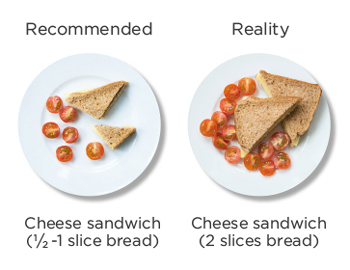 Have a routine and offer 3 meals and 2-3 planned nutritious snacks each day, rather than allow grazing.
Have a routine and offer 3 meals and 2-3 planned nutritious snacks each day, rather than allow grazing.
Mums The Word Layla Rogers, 29 and mum of one, used the portion sizes and told me: ‘I was shocked to find out I was giving my 18 month-old too much food. In fact, I’ve always worried more about my toddler eating too little rather than too much and I’d offer additional food and snacks in between meals to reassure myself that she was eating enough. It was really useful to see the actual amounts that should be the norm for toddlers. It’s helped me change not just how much food I put on the plate but also some of those feeding habits that are ingrained in all of us such as encouraging children to clean the plate!’ Top Tips for Parents
- No Grazing Have a routine and offer 3 meals and 2-3 planned nutritious snacks e.g. fresh fruit, vegetable sticks, cheese cubes, oatcakes, breadsticks or crackers each day, rather than allow grazing.
- Avoid Reward Association Don’t use food or drink as a reward for eating other foods first, for good behaviour, a treat or comfort. Reward your toddler with your attention e.g. play, read or talk to your toddler
- Distract Distract your child with an alternative activity if they ask for food between their meals and planned snacks.
- Cut Down on Milk After 12 Months Limit milk drinks to 3-4oz (100-120mls) per day - toddlers need less milk than babies.
- Let Them Say When They are Full You decide which nutritious foods to offer, but let your toddler decide how much to eat. Never insist your toddler eats everything on his or her plate
- Limit Sweets and Crisps If given, limit sweets and crisps to one item once a week and decant a small amount into a little pot rather than giving your child the whole packet.
- Turn on the Tap Water is the best choice for drinks. If you offer fruit juice or squash dilute them about 1 in 10 with water.
Limit sweets and crisps to one item once a week
Check out how you are doing If you want to check out how you are doing, try Tot It Up, a toddler food tracker giving a summary of a toddler’s daily - or more importantly, weekly – food intake compared against current recommendations, together with tips on how to make small changes to maintain the right balance: http://www.infantandtoddlerforum.org/tot-it-up-login Join the chat Follow The Infant and Toddler Forum and join the chat on Facebook at www.facebook.com/InfantandToddlerForum/ and Twitter at twitter.com/InfTodForum #rethinktoddlerportionsizes …………………………….. *% of parents who chose at least one food portion (meals, drinks and treats) above the recommended range at least once across all the portion size questions **Adult portions based on SACN 2011 average energy requirements for adults: page 85 of http://bit.ly/dietary-reference-for-energy
REFERENCES 1. http://www.hscic.gov.uk/catalogue/PUB19109 2. Online survey of 1000 UK parents of children aged 1 – 4 years conducted by Health Focus during April/May 2016. Sample was representative of the UK population by SEG, Region and Ethnicity within +/- 3% 3. Aston University (2016). ‘Rewarding children with food could lead to emotional eating’: http://www.aston.ac.uk/news/releases/2016/april/rewarding-children-with-food-could-lead-to-emotional-eating/ 4. Syrad, H., Llewellyn, C.H., Johnson, L., Boniface, D., Jebb, S.A., van Jaarsveld, C.H.M. & Wardle, J. (2016). ‘Meal size is a critical driver of weight gain in early childhood’. Scientific Reports 6: http://www.nature.com/articles/srep28368
About the Author Judy More is a registered Dietitian and Nutritionist specialising in children’s nutrition. She is a past Chairman of the Paediatric Group of the British Dietetic Association (BDA). Judy has worked in both teaching hospitals and NHS community trusts and has her own consultancy www.childnutrition.co.uk, advising government departments, companies, schools, nurseries, private patients and community groups. She also offers training and writes books and nutrition articles. Her current interests are in children’s public health issues.
